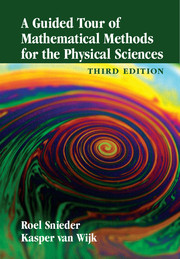Book contents
- Frontmatter
- Contents
- List of figures
- List of tables
- About the authors
- 1 Introduction
- 2 Dimensional analysis
- 3 Power series
- 4 Spherical and cylindrical coordinates
- 5 Gradient
- 6 Divergence of a vector field
- 7 Curl of a vector field
- 8 Theorem of Gauss
- 9 Theorem of Stokes
- 10 The Laplacian
- 11 Scale analysis
- 12 Linear algebra
- 13 Dirac delta function
- 14 Fourier analysis
- 15 Analytic functions
- 16 Complex integration
- 17 Green's functions: principles
- 18 Green's functions: examples
- 19 Normal modes
- 20 Potential field theory
- 21 Probability and statistics
- 22 Inverse problems
- 23 Perturbation theory
- 24 Asymptotic evaluation of integrals
- 25 Conservation laws
- 26 Cartesian tensors
- 27 Variational calculus
- 28 Epilogue, on power and knowledge
- References
- Index
27 - Variational calculus
Published online by Cambridge University Press: 05 March 2015
- Frontmatter
- Contents
- List of figures
- List of tables
- About the authors
- 1 Introduction
- 2 Dimensional analysis
- 3 Power series
- 4 Spherical and cylindrical coordinates
- 5 Gradient
- 6 Divergence of a vector field
- 7 Curl of a vector field
- 8 Theorem of Gauss
- 9 Theorem of Stokes
- 10 The Laplacian
- 11 Scale analysis
- 12 Linear algebra
- 13 Dirac delta function
- 14 Fourier analysis
- 15 Analytic functions
- 16 Complex integration
- 17 Green's functions: principles
- 18 Green's functions: examples
- 19 Normal modes
- 20 Potential field theory
- 21 Probability and statistics
- 22 Inverse problems
- 23 Perturbation theory
- 24 Asymptotic evaluation of integrals
- 25 Conservation laws
- 26 Cartesian tensors
- 27 Variational calculus
- 28 Epilogue, on power and knowledge
- References
- Index
Summary
Variational calculus is concerned with finding functions that minimize or maximize a prescribed property. As an example we showed in Section 10.2 that the shortest curve in a plane that connects two points is a straight line. This is, of course, a problem with an obvious answer, but often the answer is not obvious. Maximizing or minimizing properties of functions is not only of interest in mathematical problems such as, for example, finding the shortest curve on a sphere between two points as shown in Section 27.3. Variational calculus also sheds a new light on physics: we show in Section 27.5 that Newton's law can be derived from minimizing the time-average of the difference between kinetic and potential energy, and use variational calculus in Section 27.6 to show that rays are curves that render the travel time stationary. In the remainder of the section we treat optimization problems that are subject to a constraint. An example of this is shown in Section 27.9 where we derive the shape of the Gateway Arch in St. Louis. This last example shows that variational calculus is not just a mathematical topic; it has numerous applications in engineering.
27.1 Designing a can
In many applications the ratio between the volume and surface area of an object is an important parameter. Chemical reactivity is aided by relatively large surface areas, for example. Manufacturers of soda-drink cans want to minimize the amount of aluminum to use. In theory, both applications ask for spherical objects, as these have the largest volume to surface area ratio. Clearly, for drinks, a spherical can is not practical: how would you set your opened drink on the table, for example? We therefore restrict our can design for the moment to cans with a cylindrical shape. A squat can with a small height and a large radius has a small volume, but a tall can with a large height but a small radius cannot contain much either.
- Type
- Chapter
- Information
- A Guided Tour of Mathematical Methods for the Physical Sciences , pp. 518 - 544Publisher: Cambridge University PressPrint publication year: 2015



